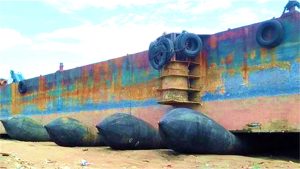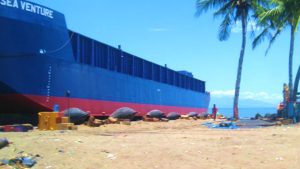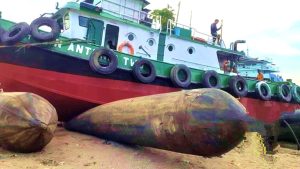Drydocking is a critical process in the world of ship repair, ensuring that vessels receive necessary maintenance and repairs. In recent years, a new method has emerged as an innovative alternative: drydocking using airbags. This technique, which is gaining popularity, particularly in Metro Manila, Cavite, Batangas, Cebu, Davao, and Zambales, has revolutionized the way ships are repaired, providing a cost-effective and efficient solution for maritime industries worldwide. With its remarkable benefits and growing prominence, it is essential to delve into the intricacies of drydocking using airbags in the Philippines and explore how this ingenious approach is transforming the ship repair landscape in Luzon, Visayas, and Mindanao.
Click here to view our drydocking and ship repair services.
Overview of Drydocking and Ship Repair Industry in the Philippines
The Philippines has emerged as a major player in the global ship repair and drydocking industry. With an extensive coastline spanning over 36,000 kilometers and strategically located in the heart of Southeast Asia, the country offers competitive advantages for shipowners looking to carry out repairs or modifications on their vessels.
One of the unique aspects of ship repair in the Philippines is drydocking using airbags. Rubber airbags provide a cost-effective and efficient method for lifting ships out of the water, making it a preferred choice for many shipyards. These airbags are placed underneath a vessel’s hull and inflated with compressed air, allowing the ship to be safely lifted above water level. This innovative technology not only reduces downtime but also minimizes environmental impact as it eliminates the need for dredging or excavation.
Furthermore, another key advantage that sets Philippine shipyards apart is their expertise in both commercial and naval vessel repairs. From routine maintenance tasks to complex structural works, these shipyards are equipped with state-of-the-art facilities and a highly skilled workforce capable of handling various types of vessels, including military ships. This versatility has attracted international clients seeking quality services at competitive prices.
The Philippines’ thriving ship repair and drydocking industry offers numerous benefits, such as cost-efficiency, environmental sustainability through airbag technology adoption, as well as expertise in naval vessel repairs.

Importance of Efficient and Cost-Effective Ship Repair
Drydocking using airbags has emerged as a game-changer in the ship repair industry, revolutionizing the way vessels are maintained and repaired. This innovative technique not only ensures efficient and cost-effective repairs but also minimizes downtime for ships. Drydocking using airbags provide a flexible alternative to traditional drydocking methods, allowing ships to be lifted out of the water without the need for costly and time-consuming infrastructure.
One major advantage of drydocking using airbags is its ability to accommodate various vessel types and sizes. Unlike fixed structures, which have limited capacity and can only accommodate certain types of vessels, airbags can be customized to fit any ship’s dimensions. This flexibility eliminates the need for expensive modifications or construction work that would otherwise be required with traditional drydocks.
Furthermore, this method significantly reduces downtime for ships during repairs. With traditional drydocking, vessels may spend weeks or even months out of service while repairs are carried out. In contrast, using airbags allows for a much faster turnaround time, as there is no need for extended periods on land or in dry docks. Ships can be lifted out of the water quickly and efficiently using airbag technology, providing expedited access to necessary repairs while minimizing disruption to their operations.
Efficient and cost-effective ship repair is vital to maintaining the performance and longevity of vessels without breaking the bank or causing unnecessary downtime.

History of Drydocking Using Airbags
Drydocking in the Philippines has been an integral part of maritime operations for centuries, serving as a crucial maintenance and repair method. Traditionally, drydocking involved flooding a dock or basin to bring a ship into a stationary position. However, with advancements in technology, Drydocking using airbags has revolutionized this age-old practice.
Drydocking using airbags in the Philippines offers several advantages over traditional methods. One notable benefit is its cost-effectiveness. Unlike the construction of permanent docks or basins, airbags are portable and can be easily transported and installed at different locations. This flexibility reduces the need for specialized infrastructure and lowers operational expenses significantly.
Moreover, drydocking using airbags in Luzon, Visayas, and Mindanao minimizes environmental impact by reducing water usage and avoiding contamination from toxic materials present in ship hulls. By lifting vessels out of the water, it allows for safer and more efficient inspections and repairs without affecting marine ecosystems.
History illustrates that shipyards have constantly adapted their practices to meet changing requirements. The introduction of Drydocking using airbags is not just another chapter in that story; it represents a significant technological leap forward in terms of efficiency, cost-effectiveness, and sustainability.

Advantages of Using Airbags for Ship Repair
One of the key advantages of using airbags for ship repair in the Philippines is their versatility and ease of use. Unlike traditional drydocking methods that require cranes or other heavy equipment, airbags are lightweight and portable. This means they can be easily transported to the desired location and positioned underneath the vessel with minimal effort. This not only saves time but also reduces costs associated with labor and equipment rental.
Another advantage of utilizing airbags for ship repair in Tanza, Cavite, is their ability to provide an even distribution of pressure along the hull. When inflated, these air-filled devices exert uniform pressure on the entire length of the ship, which helps prevent distortion or damage to its structure during repairs. Additionally, this even distribution of force allows for better control over stabilization and alignment, reducing the potential risks associated with imbalances.
Furthermore, drydocking using airbags in the Philippines offers greater flexibility in terms of options for launching a vessel after repairs are complete. Due to their buoyant nature when filled with air, they provide a smooth launch process as ships can simply slide down into the water without any significant impact or strain on them. This not only minimizes potential damage but also enables cost-effective operations by eliminating additional resources such as tugboats or slipways.
Drydocking using airbags for ship repair in the Philippines offers several advantages, including versatility, ease of use, even distribution of pressure during repairs, and flexibility in launching vessels post-repair. These benefits make them an attractive solution for drydocking needs, as they streamline processes while ensuring safety and cost-effectiveness.

The Role of Airbag Technology in Ship Repair Industry in the Philippines
One of the latest advancements in ship repair technology is the use of airbag technology for drydocking. In the Philippines, this innovative method has been gaining traction and revolutionizing the ship repair industry. Airbags are inflatable structures made from high-strength materials that allow ships to be safely lifted out of water, making drydocking using airbags a more efficient and cost-effective process.
One key advantage of drydocking using airbags is their versatility. These air-filled structures can be strategically positioned under a ship’s hull to provide even lifting force, minimizing stress on the vessel’s structure. This not only ensures a more balanced lifting operation but also helps prevent damage during the transfer onto the dock. Additionally, airbag technology allows for quick and easy adjustment as required, allowing repairs or inspections to be conducted efficiently without compromising safety.
Another significant benefit is that airbag drydocking reduces downtime for ships undergoing repairs or maintenance. Compared to traditional methods like slipways or floating docks, which require lengthy preparations and waiting times due to tide constraints, airbag technology enables faster and more flexible drydock operations. This advantage is particularly valuable in an industry where time is money – rapid turnaround times mean reduced costs and increased productivity for ship owners or operators. By embracing this cutting-edge approach, the Philippine ship repair industry can enhance its competitiveness while ensuring superior quality standards – elevating its position as a preferred destination for ship repair services in Southeast Asia.

Process of Drydocking Using Airbags in the Philippines
Drydocking is an essential process in the maritime industry to maintain and repair vessels. In recent years, a new method has emerged in the Philippines that has revolutionized this process: drydocking using airbags. Unlike traditional drydocking methods that require massive cranes and docks, airbags provide a more flexible and cost-effective alternative.
The process begins with deflated airbags placed beneath the vessel’s hull. As the airbags are gradually inflated with compressed air, they exert pressure on the hull, lifting it above water level. This allows for inspections, cleaning, painting, and repairs to be carried out without the need for a dry dock or disrupting regular port operations. The use of airbags also reduces time constraints significantly compared to other methods.
Furthermore, one of the significant advantages of using airbags is their ability to distribute weight evenly along the vessel’s length by adjusting their pressure accordingly. This eliminates stress points that could potentially damage the hull during drydock periods. Moreover, since no extensive infrastructure modifications are required for this method, smaller shipyards can now offer efficient drydocking using airbags at more competitive rates.
Drydocking using airbags in the Philippines offers numerous benefits over traditional methods. It minimizes downtime while maximizing efficiency and versatility in maintaining and repairing vessels of various sizes without incurring excessive costs or inconveniences commonly associated with conventional approaches.
Are You Looking for a Drydock Company that Uses Airbags in the Philippines?
Amaya Dockyard & Marine Services Inc. (ADMSI) is the drydock company you’ve been searching for in the Philippines. Why? Because they offer an innovative and cost-effective solution using airbags for drydocking vessels. Unlike traditional methods that often require expensive infrastructure, ADMSI utilizes specialized airbags to lift and support vessels out of the water.
- Email us: info@amayadockyard.com
- Call our 24-hour hotline: +63 917 633 0479
- Viber: +63 917 633 0479
- WhatsApp: +63 917 633 0479
- Facebook Messenger: Click here
- Click here to inquire
What sets our company apart is our commitment to efficiency and sustainability. By utilizing airbags instead of traditional drydocking methods, we reduce the need for extensive construction and infrastructure, minimizing both time and costs. Additionally, using rubber airbags significantly decreases pollution associated with concrete platforms or costly cranes.
Moreover, Amaya Dockyard & Marine Services Inc. recognizes that each vessel has unique requirements. With our experience in handling various types of ships, we are able to provide tailored solutions to meet specific needs. Whether it’s a small yacht or a large commercial vessel, our team of experts ensures that every drydocking operation is executed seamlessly.
If you’re looking for a drydock company in the Philippines that embraces innovation and cost-effectiveness while prioritizing sustainability, look no further than Amaya Dockyard & Marine Services Inc. Our utilization of airbag technology sets us apart from other companies in the market by providing efficient and customizable solutions for all your drydocking needs in Manila and Cavite. Trust us to protect your vessel while minimizing environmental impact – because, at Amaya Dockyard, excellence goes hand-in-hand with responsibility.
Future Prospects and Advancements in Drydocking Technology
Drydocking, the process of lifting ships out of water for inspection, repair, or maintenance, has undergone significant advancements in recent years. One such breakthrough is the use of airbags to drydock vessels more efficiently and effectively. These airbags, made from a strong and durable material, provide buoyancy and support to raise ships out of water. This technique eliminates the need for traditional drydocks or cranes, reducing costs and increasing flexibility.
The future prospects for drydocking using airbags in the Philippines are promising as researchers continue to improve this technology. By refining the design and construction of these airbags, experts aim to lift larger vessels with ease while ensuring their stability during maintenance work. Additionally, advancements in automation can revolutionize drydocking by streamlining operations through computer-controlled systems that precisely inflate airbags and control their movements.
The success of implementing this innovation depends on a collaborative effort between shipyards and manufacturers as they push for newer materials that are lighter yet stronger. Exploring alternative methods like magnetic levitation could also prove to be game-changers in expanding the possibilities within drydocking technology. As we enter an era driven by sustainability concerns, it is crucial that these advancements not only enhance productivity but also reduce environmental impact by employing eco-friendly materials and energy-efficient systems.
In conclusion, the future outlook for drydocking utilizing airbag technology appears bright. With ongoing research efforts focusing on enhancing performance and efficiency while exploring novel approaches like magnetic levitation, we can anticipate significant progress in this field.
Takeaway: Drydocking Using Airbags is Revolutionizing Ship Repair in the Philippines
Drydocking using airbags has revolutionized the technology of the ship repair industry in the Philippines, providing faster and more cost-effective solutions for vessel maintenance. This innovative method eliminates the need for traditional drydocks, which can be time-consuming and expensive to build. With airbags, ships can be lifted out of the water onto a specially designed platform, allowing repairs to be carried out efficiently.
One of the major advantages of drydocking using airbags in the Philippines is its flexibility. It can be used for a wide range of vessels, from small fishing boats to large cargo ships. This versatility makes it a popular choice among ship owners and operators in the Philippines, as it eliminates the need for multiple drydock facilities catering to different types and sizes of vessels.
Additionally, drydocking using airbags in our dockyard facility in Tanza, Cavite significantly reduces downtime for ship repairs. Traditional drydock operations often require weeks or even months to complete, causing delays in vessel availability and increased costs due to loss of revenue. On the other hand, with airbags, ships can be quickly lifted from the water surface onto a stable platform, where repairs can begin immediately. This efficient process minimizes downtime and ensures that vessels can get back into operation as soon as possible.
Airbag drydocking in the Philippines has brought about a revolution in ship repair by offering fast and cost-effective solutions while reducing downtime significantly. The flexibility of this technology allows it to cater to various types and sizes of vessels without requiring specialized infrastructure or multiple drydock facilities.
